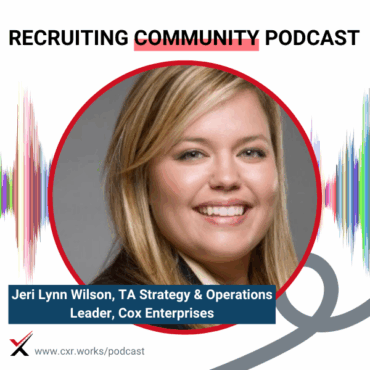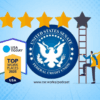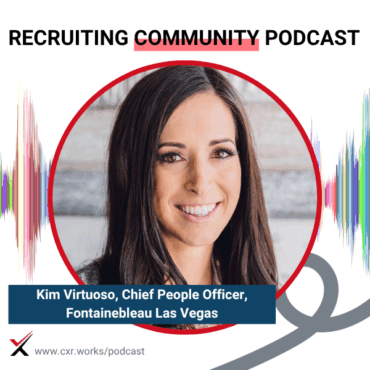Chris Hoyt: I think you’ve just gotten back from a trip. You spent a little time in Europe.
Rebecca Warren: Yes. My husband had a month-long sabbatical for his job, so he was able to float about without working. I peppered work in here and there. He spent time in Scotland, London, and Ireland. It was a great trip.
Chris Hoyt: Toward the end of the vacation, I’ve learned the last two days need to be a wind-down location. And you’ve got to come home on a Friday or Saturday.
Rebecca Warren: Yes, a hundred percent.
Gerry Crispin: Yeah, it’s real. I also like the idea of a sabbatical. I think I need to think about that a little bit more.
Chris Hoyt: Yeah, because your work is so hard, Gerry. Everybody needs a break.
Gerry Crispin: Well, I am taking one when I take a delegation to Vietnam in November. Every year I want to go to a different country I’ve not been to—not so much for the tourism, but for questioning ministers about how they incentivize work, talking to professors and students, and talking to folks who recruit, hire, and manage people in those countries.
I find that stepping outside the box stimulates thinking about how culture impacts recruiting and management in such an interesting way. Chris joined us when we went to Japan, and it was mind-blowing.
Chris Hoyt: I loved it so much I’m going back now for the tourism. I’m going back in November.
Well, I know we have robot AI things to talk about—like Kung Fu robot. Are we ready to jump in?
Announcer: Welcome to the Recruiting Community Podcast, the go-to channel for talent acquisition leaders and practitioners. This show is brought to you by CXR, a trusted community of thousands, connecting the best minds in the industry to explore topics like attracting, engaging, and retaining top talent. Hosted by Chris Hoyt and Gerry Crispin. We are thrilled to have you join the conversation.
Chris Hoyt: Welcome, everybody, to the Recruiting Community Podcast. I am Chris Hoyt, president of CXR. I’m here with Gerry Crispin, co-founder of CareerXroads. Gerry, how are you?
We’re the hosts of this podcast. Ideally, we’re trying to bring you industry insights and updates in the form of a fun and friendly conversation. It’s brought to you by the CXR CareerXroads community.
Today, as advertised, we’re talking agentic AI in TA. I know you’re going to change the dial—if you have a dial; I don’t know how old I am—because everybody’s talking about agentic AI. But I think we’ve got somebody here today who’s going to share insight and practical knowledge and what they’re seeing in the space.
It actually aligns really well with what Gerry, I, and the CXR team have been seeing when we talk to TA leaders. Every month we do an open mic with over 120 leaders who join these calls virtually. All 120 don’t join every call, but we have a couple dozen that join every month to talk about what’s top of mind. This topic of agentic and adoption and use continues to come up. I’m excited to talk about what that really means for TA leaders today.
A couple of housekeeping things: we are streaming on the socials—YouTube, Facebook, LinkedIn, and even Twitch. I don’t know how much longer we’ll be on there, but if you’re interested, check out the newly designed cxr.work/podcast site. You can see past and future episodes. The new design makes it easy to subscribe and provide input. If you’ve got people you think should be on, let us know. We’re interested in meeting new folks all the time.
One last reminder: it’s an ad-free labor of love we do. Gerry, did anybody pay to be on here?
Gerry Crispin: No, not that I know.
Chris Hoyt: Yeah, nobody’s paying us to be on here, that’s for sure.
So with that, let’s introduce our guest today. Rebecca Warren, you are the Director of Talent-Centered Transformation—
Rebecca Warren: Well done. It’s a mouthful.
Chris Hoyt: —over at Eightfold, who are CXR members, so we’re excited to have you on. Can you share: what on earth does Director of Talent-Centered Transformation mean?
Rebecca Warren: What does it mean? Our role sits in marketing, and we support pre-sales and our current customers. Our goal is to look at work through the lens of talent. Yes, we are a software org, but our goal is to keep people in the process—focusing on potential and folks at the table, not just org charts and job descriptions.
We spend a lot of time with folks thinking about what that transformation looks like. It’s not easy. It takes a lot of conversation to get people comfortable with making a shift. Our job is educating, creating content, spending time on the socials, creating blogs, and doing enablement for our internal sales teams to help them feel more confident when they go out—not just about software features and functions, but about the industry: what’s happening, what’s changing.
Chris Hoyt: Yeah—what is the application doing? What’s it doing to the space?
Rebecca Warren: Exactly.
Chris Hoyt: Rebecca, before we dive in—we’re going to set the baseline—let’s learn a little about who we’re talking with. We’ve known you for a while, but for those who haven’t had the pleasure of meeting you, give us the escalator pitch. Who is Rebecca? Why should we be listening? What work puts you up here to say, “Pay attention”?
Rebecca Warren: Okay, that’s a tall order to encapsulate. I’ve been in the TA space for a long time. Gerry, Chris—we were all circulating around the same time. I remember smiling and dialing, fax machines, the world before job boards—all the things. It was relationship building, spending time with folks, and creating processes. It was always important to me to keep people in the center.
I was a TA practitioner up to senior director at several large restaurant, retail, and agriculture companies. I learned a lot and met fantastic people. Then I transitioned over to Eightfold. I’m a poster child for potential and skills versus job titles because I was the first hired into customer success—not knowing customer success or tech. The transference of what I was doing in TA helped me at Eightfold.
I spent a couple years in customer success, hearing what end users were talking about—what’s happening, what it looks like. I also spent time in steering committees talking with leaders about what’s important to them and what’s changing at their level. Then I came over to Talent Transformation, a brand-new department we built up with just a couple of us, helping other people make that transition.
I’ve sat in TA, under Legal, in Customer Success, under Service Delivery, and now under Marketing working with Sales. I’ve got a wide swath of experience. Having a continuous learner mindset has helped me absorb new things and keep asking, “What’s next?” and “Why does it matter?”
Chris Hoyt: I love it. So, Rebecca, what’s been your favorite part of this interview so far?
Rebecca Warren: Talking about Europe. Oh wait, is that the wrong answer?
Chris Hoyt: No, it’s great. I had a little involuntary reaction when you said “fax machine,” and we try not to say the F word.
Rebecca Warren: I’m sorry.
Chris Hoyt: I immediately pictured my shirt from Office Space—out there breaking the printer. Let’s take a bat to it.
Rebecca Warren: Totally get it.
Chris Hoyt: Who’s got a roll of resumes waiting on a fax? I remember those days.
Let’s set the stage. Folks are dialed in—or they’re not sure why—but they’re here to hear about agentic AI. We’re hearing that term a lot. Some leaders are frustrated because just when they think they’ve wrapped their heads around using AI—cleaning up job descriptions or whatever they’re enabled to use—along comes this term “agentic.”
Can you define agentic AI in the context of recruiting and break down how it differs from more familiar AI applications like chatbots and automation?
Rebecca Warren: If you think about a chatbot or automation, you put together a list of things and the bot automates it. It checks the boxes and does what it’s told.
GenAI—ChatGPT, Claude, Gemini—looks at a ton of data and creates new content, making assumptions (sometimes good or bad).
Agentic AI is about an “agent” giving agency to technology to create and execute a process from beginning to end without human intervention. If we think about an agentic workflow in TA, it could be the entire hiring process completely automated without human intervention. It’s the Waymo of recruiting. The tech is in the driver’s seat, with input and guardrails from humans. Does that make sense? Is that how you’re thinking about it?
Chris Hoyt: Completely. I love the idea of agentic “armies” taking on redundant work—repetitive work that’s more complex than it needs to be for someone who should be focused on relationships. That’s a big part of the debate: how much of the recruiting job it eventually assumes.
My next question: why should TA leaders care about this shift now versus waiting to see how it unfolds?
Gerry Crispin: In PwC’s study of TA leaders, 72% were not using AI. They were concerned, fearful, told by their bosses they couldn’t, or too busy. You saw nothing along the spectrum until you got to 25% who were “all in.”
You’re really looking at a bifurcation. That 72% will be seriously concerned about getting or keeping a job in the next couple of years. I wouldn’t hire someone who can’t answer, “How have you been embracing, engaging, or defending your ability to transform recruiting with AI?” If you can’t answer, you wouldn’t be on my final list.
Chris Hoyt: With that in mind—and without just saying “buckle up, buttercup”—why should TA leaders care now versus waiting? When social media came out, those of us old enough to remember weren’t allowed to use it for work. It was shut down; you needed special access. We snuck around anyway because it was coming and nothing could stop it. Is this different?
Rebecca Warren: I think it’s fundamentally different because “wait and see” means being left behind. This is happening so fast. It’s not about slowly implementing a job board and seeing what happens. AI is the slowest it will ever be today, and it already feels like a runaway train. It’s not going to slow down. Things will continue to integrate into work.
I think a lot of fear comes from the fact that we built TA from the ground up. I was in it when it was personnel, then selection, then recruiting, and now TA. Much of what makes it what it is today are things we built manually—on paper and whiteboards. Christopher McCormick, who was on a webinar I did about agentic AI, said: we put our value on being “human doings” instead of “human beings.” We put our value on tasks instead of what we’re capable of creating, supervising, or managing.
We have to talk about it and say, “Yes, we’re scared.” I interviewed folks at Cultivate, our talent summit. Every person embracing it said it’s scary and uncomfortable. But that’s where we are. We have to embrace the uncomfortable. We don’t have a five-year plan; we’re thinking about the next four to six months. If you don’t pay attention now, you’ll be left behind. Your company may be out of business.
Chris Hoyt: If we level set, what are early examples of agentic AI within recruiting that you’ve already seen? Some leaders may have seen it in practice and not realized it.
Rebecca Warren: We heard from Gartner that only 2% of the workforce is ready for full agentic workflows. But agentic agents absolutely make a difference now and let people put a toe in the water.
Scheduling can be fully autonomous—from first reach-out to reschedules, getting it on the calendar, and sending the details. That’s fully autonomous until someone shows up on the Zoom and says, “Hey, how are you?” Scheduling is an easy one—there’s a blend of automation and genAI, with content writing and real-time shifts.
Another space is the interview process—using an agentic interviewer. When we first rolled it out, I wasn’t sure what to think. I tried it. I was the worst candidate ever—said silly things, got distracted by the cat. It was able to shift. When I said, “I don’t have an answer,” it said, “Great, let’s move on.” I asked in-depth questions, and it provided information. An agentic interviewer is probably the next thing we’ll see as a toe in the water, and then it will continue to build throughout the workflow.
Chris Hoyt: Gerry, we’ve done at least a dozen of these virtual interviews with a bot on the other end.
Gerry Crispin: The biggest issue for me in that area is radical transparency about why I’m talking to something that’s not human. Why should I be talking to you? I want a human. The answer should be upfront: there are 223 people who just applied. No human is going to interview 223 people, but I will. I’ll interview in whatever language you’d like. I can be humorous or straightforward, but I’ll ask everyone the same questions so it’s fair.
Rebecca Warren: And I can do it at 3:00 a.m.—whenever you want.
Gerry Crispin: Exactly. I don’t see enough of the new technology being aggressively transparent about the rationale—why you should pay attention. This can be fairer and more consistent. It can take care of everyone at the top of the funnel.
Chris Hoyt: I think that’s a cosmetic fix with any of the tech we’ve seen—setting the stage up front.
Gerry Crispin: Then you have to deliver on it. That’s the tech piece. But saying it is simple and I see almost all of them missing it. When I tell them, they say, “We allow the person to say it’s not human.” That’s basically it.
Chris Hoyt: I think that will be a customer option, like with chatbots—how much gets disclosed up front.
Gerry Crispin: That’s the biggest problem with ATSs. We left too much to the customer to add simple features, and they never did. It just pissed off everybody.
Chris Hoyt: You’re having a philosophical debate about a technology component that should be handled.
Rebecca Warren: There’s an overarching challenge: as recruiters, we used to pride ourselves on the eight-second resume scan. We hoarded salary information because it felt like leverage. Where we need to go overall is trust and transparency. We hear it over and over. Candidates and employees want to know: can I trust you? Do you have my best interest in mind? Will you be transparent and tell me when you don’t know?
Leaders think we have to know and do all the things. That’s not real. We don’t know what’s going to happen next week sometimes. Trust and transparency need to happen in all spaces—from what’s happening with your data during the process all the way through what’s happening once you’re hired.
Gerry Crispin: That is the change management issue.
Chris Hoyt: It is and isn’t. I’ll disagree with both of you. You’ve transcended from talking about agentic AI to talking about leadership transparency. It doesn’t matter what the tech is—agentic, chatbot, or a Calendly link—you’re talking about being transparent and upfront. That’s good leadership.
Rebecca Warren: It’s an easy fix, as you said. Throw that upfront—and maybe don’t make it optional. If you’re going to use our tech, this is how it works, based on what our AI council has said and what we’ve heard. Maybe that’s just built in.
Chris Hoyt: I love that idea. I don’t think a company trying to sell that product will refuse a customer because the customer doesn’t want to be as transparent.
Gerry Crispin: I’d love to see it. That’s why change management is key. Most employers won’t be as transparent as we’re discussing. If I’m a candidate and I ask the agentic, non-human interviewer to tell me about the hiring manager—
Chris Hoyt: You’re moving into fantasy. The system isn’t going to know that this person lost several people—
Gerry Crispin: A great recruiter trying to build trust with a candidate they want would be open and honest: this will be a challenge; you’ll need to manage the manager. A great recruiter knows how to do that with the right candidate at the right time.
Chris Hoyt: Okay, Rebecca—robots aside—Gerry makes a valid point. Where do you think agentic AI will have the biggest short-term impact when implementing today? Is it sourcing, screening, candidate experience, something else? Where do we get the biggest bang for the buck now?
Rebecca Warren: I think yes—across the board—but let me be specific. Gartner says HR leaders feel agentic AI will significantly alleviate talent challenges in the next five years. If you’ve got 223 applicants for a role overnight and you give them the option to interview whenever they want in the next week, think about a typical process: we look at who came in first, narrow it down, maybe go to LinkedIn Recruiter. We might review a third of the applicants—sometimes just the top and bottom pieces, and everyone in the middle is out of luck.
Agentic interviewing changes that. Talent discovery is huge. If you had an interview with every single person who applied—capturing what they want to do, what’s important to them—that data becomes additional signal. If we get that into a database and use those data points, what does that do for sourcing? Every lead in your database is a potential warm lead. With more information, we become more proactive than reactive.
Chris Hoyt: I’m aligned. My stance: it obliterates sourcing as we know it today. Gone are the days of needing a small team of people who can click-click-clack a Boolean search and dig out undiscovered talent. Will we still need that talent? Sure, but nowhere near the scale we historically relied on.
Imagine you’re Nike getting 60–70,000 applications a month—being able to fully interview all of them dynamically and automatically, with transparency across the board. Then classify where the best matches are for roles as they come available—not waiting on reqs to open, but queuing this up. It’s a game changer.
Gerry Crispin: Another plus: it eliminates what’s currently happening where candidates are using AI to create resumes and applications. This provides a more authentic and consistent approach to collecting data and expands what you can collect and use.
Chris Hoyt: I think we lose a component of authenticity with how candidates are using AI now. The complaint is we need some Ozempic for the top of our funnels—it’s out of control. You’ve got multiple versions of the same person’s resume, or ten resumes that look identical for ten different people. Until that normalizes, I’m not sure it’s an advantage on either side.
Gerry Crispin: It’s garbage in, garbage out. We have to find a new way to collect data that’s more effective. Connecting the top of the funnel to agentic interviewing will solve that problem.
Rebecca Warren: Two thoughts. First, if you expand this, it changes the need for a resume. If you interview them and have their information in your database, and then you look at the work—that is, the outcomes the company needs—you could align people to new projects, gigs, the actual work. Maybe even tasks. You get rid of job descriptions and resumes because you already have the information, and now you proactively align to outcomes, impact, and work.
Chris Hoyt: Now you’re running into the area that job descriptions are more than postings. There’s a lot of weight behind why we have them—job codes, compliance, and more. I love it, though. I think we’re probably three years away from seeing a major impact on how job descriptions are used because of that.
Rebecca Warren: I think you’re right. We’re built on a classification system—boxes and containers. Shifting that is fundamental. The other thing that needs to change is how we do the job of the TA professional. We shouldn’t say, “We’ve got five similar resumes because they used genAI, so we’ll punish them.” That’s silly. As Gerry said, if you’re not talking about AI when interviewing, you shouldn’t be on the slate.
We should rethink the process. Maybe it’s completely autonomous agentic AI doing all the interviews up front. Then those people come in and you pick a team of eight who meet your criteria and have them do a four-hour online exercise where they work together while you observe and talk with them. The way we do TA has to change based on the tech that’s coming. We’re not building a faster car—we’re building a rocket ship, and there are no roads where we’re going.
Gerry Crispin: Candidates will evolve too. They’ll have an earbud that’s read everything they’ve done, has had many coaching conversations, and has a better memory than they do—pairing accomplishments with the question asked. We’ll have to be more accepting on both sides. We can’t get mad if they have a hallucination around it.
Chris Hoyt: We want our interviewers to have a real-time assistant AI to ask better probe questions, but we can’t get mad if the interviewee wants a real-time assistant for better answers.
Rebecca Warren: Maybe our job becomes managing the tech—not just the process. Our role could be as managers of tech rather than managers of process.
Chris Hoyt: I think it’s a conductor or a team lead of agentic AI—an army of agents. That becomes a skill set and a role.
Rather than how we manage tech that’s a couple of years out, I want to talk about how we manage the tech implemented now. As I mentioned, we do that monthly call with leaders. Some are frustrated. They’re implementing impressive tools, going to bat for budget and switching costs, taking a risk. And they’re struggling with recruiter adoption.
Feedback: too many clicks, it’s not doing what was promised, “I can still do this faster.” Are you seeing the same thing through the Eightfold lens? If you are, how is that being addressed? How do you advise when a leader says, “We’ve put it in and they’re not using it”?
Rebecca Warren: The first problem when you hear that is: did you have recruiters in the seat when evaluating the tech? Were they alongside you? There’s a lot of FUD—fear, uncertainty, and doubt—because we built this space. We did it with sweat, org charts, and value stream mapping. Now someone comes in and says, “Boom—here’s your technology.”
After the pandemic, when hiring was bonkers, some folks said, “We’re going to implement all the tools for you, and you can pick which one you want.” That was crazy. People said, “We’re not going to use that because it’s uncomfortable. We’ll do what’s easiest.” We found many folks weren’t using the tech because they didn’t understand it and weren’t part of the evaluation. Senior leaders expected amazing transformation, but they weren’t talking to end users—huge disconnect.
We learned this early in our journey. We sold to senior leaders who thought it was great, but we later discovered all the end users only spoke Spanish. We hadn’t built Spanish into testing. Huge miss—but we never once heard from senior leaders that end users were Spanish-speaking.
Transparency has to start from the beginning. New tech doesn’t just affect HR or TA. You’ve got to get your CIO, ops teams, and partners involved. Open the door and say: we’re not selling tech to HR; we’re aligning to company outcomes and involving everyone.
So: involve end users early and often. Also, we’re used to doing it our way. We didn’t get here because we were bad at our jobs—we were good. There’s fear about taking our hands out of the water, and people struggle with that.
Chris Hoyt: A couple of things stand out. Understanding the problem you’re trying to fix before you buy the shiny bubble is huge. I’ve done that in my past. Some TA leaders buy the next big tech—they’re fully bought in—but they may not actually have that problem. This may not solve their pain points. That’s huge.
I love bringing recruiters along on the journey. Where I draw a line: recruiters don’t have any business driving implementation. Don’t give recruiters stretch assignments to implement tech. Don’t put a director in charge of an ATS implementation as a stretch assignment. Budget for an implementation team—someone to help—because it breaks trust. It can break relationships across the org and change career paths—not in a good way.
Change management is the Achilles’ heel of every TA leader. If they’re not careful, it can be the unexpected downfall of their career.
Rebecca Warren: Do we ever ask in interviews: talk to me about your agility? Your ability to shift if the organization pivots? We don’t. We hire for roles and expect people to do roles. Many companies are now interviewing less on the job description and more on the top 8–10 skills everyone needs—agility, communication, curiosity. We can teach a lot of things, but we can’t teach agility or the ability to shift.
Gerry Crispin: The oversight of all that’s coming needs to be a central area that’s fully staffed. Whether it’s a special implementation team or part of operations, you’ll need people who can do that.
Chris Hoyt: A hundred percent.
Rebecca, we’ve covered a lot and derailed a bit—which is great. We’re excited to have you on.
Rebecca Warren: We’ve only hit two points out of the ten I wanted to talk about, so we’ll have to do that later.
Chris Hoyt: I’d love to have you back. You’re great on the show.
We ask everyone this before we wrap up: if you were going to write a book today on this topic—the state of it—what would the title be?
Rebecca Warren: This has been my mantra for a while: Clarity Over Certainty. We need clarity in the moment instead of certainty of the future. We’ve got to figure out what we need to accomplish today. That doesn’t mean we shouldn’t think futuristically and manifest where we want to go, but for businesses to transform and change, we have to have clarity in the moment—and trust and transparency.
Chris Hoyt: I love it. Present company excluded, who gets the first signed copy?
Rebecca Warren: That’s funny you ask. My youngest son—he’s 30, not a kid—said the other day he was trying to explain to his girlfriend what I do and realized he had no idea. He asked if next time we’re together I could explain it to both of them. So I’d give it to my youngest son and his girlfriend.
Chris Hoyt: Well played. For years, those of us early on the new tech curve had family members who couldn’t explain what we do. I find that really fun. Love it.
Rebecca, thank you so much. Much gratitude. I know you’re busy and carved out time for us today. We really appreciate it.
Rebecca Warren: This has been great fun. I appreciate the chats and a little bit of challenging—it makes us better.
Chris Hoyt: You’ll notice at the end we never ask you what your favorite part was. We always do.
Rebecca Warren: It’s still Europe.
Chris Hoyt: No doubt. Thanks, everybody, for listening in. Want to catch past episodes? We’ve done about 400–500 interviews with TA leaders and practitioners doing good work. Check it out at cxr.work/podcast. Hit like and subscribe. Make us famous. Maybe we’ll write a book—you never know. Until next time, we’ll see everybody next week. Thanks, everybody.
Announcer: Thanks for listening to the Recruiting Community Podcast, where talent acquisition leaders connect, learn, and grow together. Visit cxr.work/podcast to explore past episodes, see what’s coming up next, and find out how you can join the conversation. Whether you’ve got insights to share or want to be a guest on the show, we’d love to hear from you. If you’re interested in learning more about becoming a member of the CXR community, visit us at cxr.work. We’ll catch you in the next episode.










